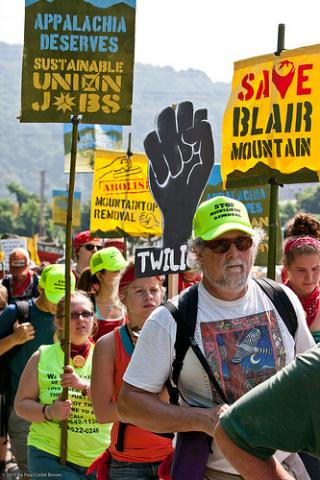I arrived a few days early to headquarters in Marmet, WV with an overly large pack that threatened to topple me over with one slightly unbalanced step. A sleeping bag, multiple changes of clothes, a bottle of Listerine, and ample bug spray would have to last me through the long and arduous journey of marching 50 miles along highways careening through the West Virginian Appalachians.
Over the next week, hundreds walked along the path of the original 1921 miners who rose up against the tyrannous coal companies in an attempt to unionize. In the 2011 March on Blair Mountain, community leaders, union members, and conservationists rallied to save the historical labor icon of Blair Mountain, sentenced for destruction via mountaintop removal mining (MTR). We marched to protest against MTR and to advocate for safer working conditions and sustainable jobs for West Virginians, whose economy and proud natural landscape have been eroded by greedy coal barons.
Back in 1921, during the battle of Blair mountain, as many as 10,000 coal miners risked their lives to stand up against coal operators by fighting for basic rights to unionize and demanding safer working conditions. Back then, coal barons exploited the miners and their families by forcing them to live in company towns were people were paid in the currency exclusive to the company. Union organizers were kept out by coal companies, which sent in hired spies to ensure the workers remained beholden to the company.
Any attempt to unionize was met with harassment, intimidation, and threat of job loss. Eventually this culminated in the largest labor uprising in US history, capped off by the deadly Battle of Blair Mountain. This uprising spearheaded the movement that would eventually lead to fair wages and fair working conditions across all job spectrums. While at one point Blair Mountain was listed on the national registry of historic places, a few years ago it was taken off due to pressure from the coal industry.
Today, King Coal still reigns in the West Virginian mountain ranges. You would never know of the grip the industry holds from the highway. The strip mining operations are purposefully hidden behind lush green mountainsides so that tourists passing through the state don’t see the devastation caused by the blasting. It’s an unfortunate well-known fact that if people do not see it, and if it’s not happening in their backyard, they are less likely to do anything about it. But the truth is, coal companies rule the roost, maintaining influence over the ranks of loyal workers to the local service industries they support, even the local authorities and courts. The industry’s iron grip on public opinion in West Virginia was palpable, especially as people arrived in town with the distinct goal of attempting to challenge it, even nonviolently.
While marchers this time around weren’t battling bullets like back in 1921, we were up against our own set of obstacles. In the week leading up to the start of the march, the coal industry started applying pressure from all sides. We were hearing rumors of local counter protesters getting ready to “stir up trouble”. There were reports that the march would be shut down on the first day by the police. Campsites that marchers intended to stay at were dropping out like flies because owners, despite being sympathetic to the cause, had to rescind their permission because of coal industry pressure.
Even when paid contracts were involved, owners refused to honor them out of fear of losing their jobs or other types of industry retaliation if they had let the protestors stay. We hadn’t even set foot on the ground before the powers that be in the area were trying to stop us. However, this wasn’t entirely unforeseen. King Coal wouldn’t be trying to stop us if they weren’t afraid of the potential impact we could have.
Despite intimidation tactics, marchers were unfazed and came in good spirits. An initial group of 200 people arrived, some all the way from Australia, some from the next town over, ready to set out on the perilous road and forge ahead despite the risks. Sure, protesting coal in West Virginia seemed to be the equivalent of walking into Mordor and flipping the bird to Sauron, but so long as there was good company, food, water, and porta potties, nothing could stop us.
Typically, we would march around 10 miles a day, trudging through 90-degree heat along narrow margins of highway road. Coal trucks came barreling past within a few inches of the marchers. There was singing and chanting throughout the line that precariously winded along the shoulder of the road, in some places offering only a foot of clearance from the traffic. Colorful signs were decorated to commemorate destroyed mountains and endangered communities threatened by mountaintop removal projects throughout the state. The first day was one of the longest days, marching around 11.5 miles, when our tired feet finally carried us to the campground we were supposed to stay at.
Counter protesters met the marchers with jeers and signs of their own. “Go Home Treehugger!” was one of the least colorful statements relayed by the group as they stood by the road and encouraged every passing car to honk in support of coal. As tensions rose, eventually the county commissioner was called out to officially declare us “not welcome” to camp, promptly followed by a police order that stated if we did not leave the park, everyone would be arrested.
Eventually all of our pre-reserved campsites would pull out due to coal industry pressure coming through different channels, whether families ties, community intimidation, or threat of job loss by the coal industry supporters. All the marchers would have to be transported back and forth each day from our one camping option to the next spot on the march, until we finally got into the town of Blair. We ended up having to spend the nights back at headquarters, and with more marchers arriving each day, the warehouse was becoming a little too cozy.
Over the next 4 days, marchers remained committed to finishing out the entire 50 miles. The atmosphere was always cheery and high-spirited, and the reaction from local citizens supporting the march was inspiring. There were accounts of people walking over an hour to the road or waiting several hours on their porch to see us pass by and wave. Others sat outside or rode past in cars to give the marchers the thumbs up or a high five.
One man was sitting at the end of his driveway on his riding lawnmower with a sign that simply read “Thank You” encircled by flowers. We walked past a school along the route that showered marchers with a round of applause as we strolled by. They said that we were doing what they were not able to because of the potential consequences. Each day more marchers joined the line until it stretched so far, you couldn’t see the end around the corners.
The last day we finally marched into Blair and set up camp. I threw up my tent and exhaled in appreciation of finally having for the first time that week, four of my own walls.
Stay tuned for Part 2, when I’ll cover the exciting rally at the summit of Blair Mountain.
Subscribe to our newsletter
Stay up to date with DeSmog news and alerts






